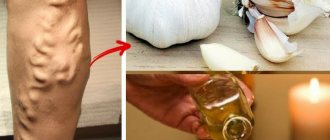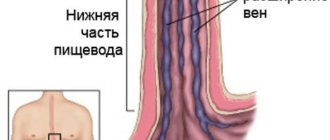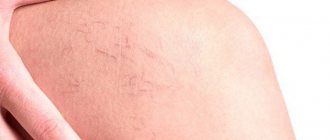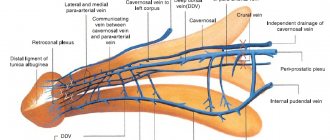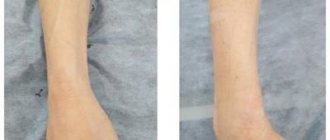Do varicose veins occur in men?
Varicose veins are an insidious disease, all doctors and all information sources say this. The insidious thing is that there is not a single category of patients that it cannot reach. As public health statistics show, the age and gender of a person does not matter; the problem has begun to occur in everyone. Therefore, it is worth looking at the disease from a different angle - in which categories of patients can it manifest itself frequently, and in whom rarely?
Indeed, women encounter on average 5 times more often vascular pathologies than men. Firstly, because there are more factors for their occurrence in women. Secondly, because men are less careful about their own health and the percentage of them diagnosing the disease in the early stages is negligible. Therefore, to the question of why varicose veins on the legs in men are dangerous and whether they are dangerous in principle, we will answer that varicose veins certainly pose a threat to general health and, in this case, to the consequences it can provoke. Read more about what causes the disease, how to identify it, how and how to treat varicose veins on the legs in men.
Causes of nodular veins in the testicles
Varicose veins of the testicles can have 2 forms:
- Primary - occurring as an independent disease.
- Secondary, when the pathology is a complication of other diseases.
Causes of varicocele:
- Heredity is a genetic predisposition
. Anomalies in the development of veins in most cases are inherited, being detected in adolescents during the period of maturation (puberty). Weak veins and vein valve defects or absence of vein valves are common, causing veins to stretch easily when blood flow increases. - Anatomical structure
. The main cause of varicocele is strangulation of the left renal vein. When pinched, testicular varicose veins are a complication associated with a powerful influx of venous blood. Symptoms appear only in a vertical position; in a horizontal position, the venous network is normal. - Tumors
in the pelvis and abdominal cavity. Large tumors infringe on the veins leading to the testicles. The pressure stretches the venous walls. - Constriction of veins
. The blood flowing in the veins presses harder, gradually stretching the walls. - Lifting weights, heavy loads during training
. When lifting weights, the abdominal muscles tense, which leads to a rush of blood to the extremities. Under load, veins that are prone to stretching expand sharply, causing varicocele. - Constipation
, diarrhea. With chronic constipation, a man has to strain, which again affects the blood flow in the lower part of the body. A similar situation occurs with prolonged diarrhea.
Excess weight and sexual activity contribute to the development of varicose veins.
Varicose veins on the legs in men: causes
To resist pathology, you should have information about it. The causes and signs of varicose veins on the legs of men are of great importance in this fight.
!
First of all, it is worth noting the hereditary factor.
It is possible to inherit varicose veins, as well as the characteristics of the connective tissue that make up the vascular walls. The main provoking factors for the development of pathology in men also include:
- bad habits - smoking and alcohol addiction;
- excessive passion for strength training;
- passive lifestyle;
- long-term driving;
- obesity;
- lack of diet and daily routine;
- chronic diseases of the kidneys, liver, etc.
All of us know that experiences weaken the body's protective functions. Can we say that varicose veins in men also arise from nerves? Such a direction of medicine as psychosomatics claims that in 75% of cases of the development of cardiovascular diseases, nerves play an important role. Therefore, an unstable emotional background may be one of the factors provoking the development of varicose veins.
Expert opinion
The etiology of vascular diseases is not fully understood. Therefore, the true list of causes and factors influencing the development of the disease can be large. Varicose veins in the legs are considered to be a polyvalent disease. In this regard, it is important to know what symptoms it has. This will allow you to see a doctor in time and receive treatment.
Vascular surgeon, phlebologist
Osipova Ekaterina Yakovlevna
Let us recall that the negative consequences of the development of varicose veins on the legs in men are formed mainly due to a late visit to a specialist, including due to ignorance of the clinical picture of the disease.
Signs of varicose veins on the legs
Preserve men's health. Varicocele: what is it and how to get rid of it?
Despite the fact that this disease is quite common, the average person knows little about it. What causes varicocele and what does it mean for a man? How are varicoceles diagnosed and treated?
These and other questions are answered by Anatoly Vladimirovich Vavilin, a urologist at Clinic Expert Perm.
— Anatoly Vladimirovich, what kind of disease is this – varicocele? Does it have anything in common with varicose veins on the legs? Sounds similar...
— Varicocele is a varicose vein of the pampiniform plexus of the spermatic cord. With this disease, the functioning of the valve mechanism of the veins is disrupted, as a result, the outflow of blood through them worsens, and the veins dilate.
This pathology is considered quite common. For example, during conscription for military service, varicocele is detected in 1-7% of young people. The highest incidence of varicocele (15-19.3%) occurs at 14-15 years of age. In children under 10 years of age, this disease occurs in 0.7-5.7% of cases.
Varicocele does not pose a threat to life, but often becomes a cause of male infertility. What is common with varicose veins of the lower extremities is that in both cases we are talking about varicose veins.
— Are the causes of the pathology known? Why does a varicocele appear?
— The disease can be congenital or acquired. Most often, varicocele is recorded in the left testicle, where the spermatic vein connects to the renal vein - this is usually the result of a congenital pathology. However, varicocele is not a genetic disease.
Less commonly, the disease affects both testicles, and even less often, only the right one. In such cases, we can talk about an acquired form of the disease, which often signals an oncological pathology. An acquired varicocele on the right can be provoked by a tumor of the right kidney, both malignant and benign.
— How does varicocele manifest?
— At the initial stage of development of the disease, most often nothing happens. At the second stage, discomfort in the groin and pain in the testicle may occur. In the third stage, the manifestations are the same as in the second.
I would like to note that pain in the testicles is not always a varicocele: the same sensations arise, for example, with chronic prostatitis, with inflammation of the epididymis.
— How is varicocele determined in men? What is the diagnosis?
— There are three stages of the disease. In the first, the dilation of the veins of the spermatic cord is not visible to the naked eye, but they can be felt. On the second, dilated veins can already be seen, and they can also be felt. On the third, all the problems are already visible so clearly that it is impossible to make a mistake with the diagnosis.
Most often, congenital varicocele is discovered by chance - during the examination of young people during a medical examination during conscription. By the way, the examination is carried out with the patient standing, because when a person lies down, these dilated veins collapse and are not visible. Also, to diagnose varicocele, an ultrasound of the scrotum is performed: you can see the size of the varicose veins and determine the stage of the disease.
Often the diagnosis of “varicocele” is made when a married couple comes to the doctor with the problem of infertility. The man submits his sperm for analysis, the doctor sees a certain problem in the spermogram, and upon examination finds dilated veins of the spermatic cord. If such a married couple wants to have children, the man first of all needs to get rid of varicocele, since this pathology affects spermatogenesis (the development of male germ cells). Why is this happening? The blood does not drain well from the testicle, it stagnates, and because of this the temperature in it rises. Not by much, about half a degree, but this is enough to cause problems with spermatogenesis.
— Can varicocele go away on its own, without treatment?
- Definitely not.
— Tell us about existing methods of treating the disease. Is it possible to cure varicocele without surgery? And is there a chance to get rid of this pathology forever?
— Not so long ago, about 15 years ago, all patients with varicocele were sent for surgery. Now, if the first stage of the disease is detected and nothing bothers the person, you can do without surgical intervention. You just need to be observed: if the varicocele does not progress, a person can live quite a long time with this first stage without any problems.
If the question of treatment still arises, then it is only surgical. If the operation is successfully performed, the person can forget about the problem.
— How are operations performed for varicocele?
— There are several options. The simplest is the Ivanissevich operation. In the left iliac region, just above the inguinal fold, the doctor makes an incision of about 5 centimeters, identifies the testicular vein and crosses it.
The Marmara operation is more complex - it belongs to the category of microsurgical. Through a small incision, no more than a centimeter in size, the spermatic cord is isolated and all small veins are ligated, after which the blood flows out through other veins.
Now another type of operation has appeared; it is a minimally invasive x-ray surgical endovascular procedure. To carry it out, you need specially trained doctors and expensive equipment, so such operations are not common and are carried out mainly in large centers.
— What are the possible complications after surgery for varicocele?
— As a rule, such operations are not burdened with any serious complications. However, it happens that the operation is performed, but the problem is not eliminated, the veins remain dilated.
One of the most common complications is recurrence of varicocele. Each type of surgical intervention has a certain probability of the pathological process returning. In the case of traditional surgery, this probability is 40%, with endovascular treatment – 15%, laparoscopy – up to 10% and with microsurgical surgery – no more than 2%.
All other complications are extremely rare and are mainly associated with violation of the surgical technique. For example, sometimes after surgery, water in the membranes of the testicle (hydrocele) may occur. This happens, in particular, when crossing lymphatic vessels.
— What are the causes of varicocele recurrence?
— The reason for the relapse is the presence of so-called backup veins, through which blood again fills the veins of the pampiniform plexus. The relapse rate during the Ivanissevich operation is higher, since during it only the common testicular vein is ligated, without taking into account the backup veins. But with a microsurgical operation (Marmara), there are fewer relapses, since all branches of the testicular vein are ligated.
— What will happen if this disease is not treated? How does varicocele threaten a man?
— As I said earlier, the disease does not pose a threat to life. However, it affects a man’s spermatogenesis, that is, it can become one of the causes of male infertility.
Read
Symptoms and signs of varicose veins in men
As a rule, men ignore symptoms such as heaviness in the legs, pain, cramps, spider veins, dryness and redness of the skin. And only when persistent swelling, large varicose veins and or even non-healing ulcerative skin lesions on the legs appear, which clearly indicate varicose veins on the right, but more often, the left leg, then they are ready to see a doctor. In this case, it is extremely difficult or practically impossible to carry out conservative treatment of varicose veins in men on the legs, namely treatment without surgery.
!
To prevent varicose veins on the legs in men from developing into advanced stages, and from requiring surgery to remove varicose veins of the lower extremities, it is important to listen to the “signals” that the body gives!
What to do and how to act correctly if symptoms of the disease are detected? As soon as a person notices one, several or all of the symptoms, he should seek advice from a specialist as soon as possible. The doctor will collect an anamnesis of the disease, perform an examination, and prescribe the necessary diagnostics to confirm the preliminary diagnosis. After which therapy will be prescribed corresponding to the stage of varicose veins.
Treatment of varicose veins
Symptoms of varicocele: the disease may be asymptomatic
In 85-88% of cases, varicose veins affect the left testicle along the blood flow. Bilateral involvement is rare, occurring in approximately 5% of diagnoses.
There are several possible options for the development of varicocele:
- Asymptomatic.
- Mild symptoms. In young men, there is a noticeable slight increase in the left half of the scrotum. It may be slightly lowered.
- Noticeable symptoms. Nagging pain in the testicles that appears or intensifies with walking, excitement, lifting heavy objects and other stress.
- Objective symptoms. A clear pattern of the veins of the testicles, their convolution. With advanced varicose veins, there is a noticeable decrease in the volume of the affected area associated with atrophy.
If you look at the affected testicle through the eyes of a urologist, a varicocele looks like this:
- weakening of veins;
- compression of veins;
- increased pressure in the veins of the testicles;
- disruption of blood flow.
Poor circulation affects the entire organ: the veins and small capillaries of the scrotum area are affected.
With a bright degree of varicocele, you can visually notice thickening, plexus and protrusion of veins. It's not pretty, but it's not scary either. Another complication of testicular varicose veins is much more dangerous - infertility caused by deterioration of spermatogenesis. Urologists often note a connection between varicocele and infertility, so they recommend treating the disease.
How to treat varicose veins on men's legs using traditional medicine?
How to treat varicose veins? In accordance with the stage at which the disease was diagnosed, conservative therapy methods and or surgery will be applied. Surgical treatment is used in cases where it is no longer possible to avoid it. There are various treatments for varicose veins. The attending physician determines which method is most suitable for the patient. How to treat varicose veins on the legs in men conservatively?
Methods of conservative therapy are varied. They are divided into medicinal and non-medicinal. The first include medications and external agents that help strengthen the vascular system, reduce fragility and increase the strength of the walls of blood vessels, as well as drugs that thin the blood and remove toxins. For these purposes, patients are prescribed phlebotonics, anticoagulants and antioxidants. The most effective are those containing heparin and troxerutin. If varicose veins in men are detected at an early stage, then to maintain the health of the lower extremities and prevent problems with blood vessels, you can use NORMAVEN® cream to reduce the syndrome of heaviness and fatigue in the legs.
Non-drug treatment methods include doctor’s recommendations for changing eating behavior and maintaining a healthy lifestyle, lifestyle modification.
!
Compression garments have a positive effect.
This type of treatment is used quite often in men. Orthopedic salons quite widely present compression products, among which there is a variety of compression hosiery: knee socks, stockings for the treatment of varicose veins of the legs. The color palette and quality of knitwear sometimes makes it difficult to distinguish them from ordinary socks. In any case, the issue of health is a priority over possible inconvenience and embarrassment. Exactly which socks or stockings and what compression class are used to treat varicose veins in men will depend on the stage of varicose veins. The class of compression hosiery is always selected by a doctor.
Clinical picture of male varicose veins (varicocele)
A characteristic feature of the disease is that varicocele is almost always left-sided. The clinical picture of this pathology is ambiguous. In some cases, unpleasant sensations or pain of a pressing, pulling nature are observed. As a rule, they occur after heavy physical exertion, thermal procedures, sexual intercourse, that is, they are temporary. Most often, the patient finds it difficult to answer the question regarding the location of the pain that has arisen.
A common symptom of varicocele is pain
Many patients have an asymptomatic course of this disease. And here there are two options: either varicocele will lead to infertility, or it will have a sluggish form, without progressing in its development.
How to treat varicose veins on the legs in men at home or treatment with folk remedies
In the first stages, varicose veins in men can be treated at home, including using folk recipes, but only after consulting a doctor. At home you can:
- perform therapeutic exercises (“bicycle”, “birch tree”);
- do massage and self-massage, incl. using orthopedic mats;
- take water procedures (baths with decoctions, contrast showers);
- make lotions and compresses (from sea salt, honey, apple cider vinegar, wormwood);
- rub your feet with rubs based on horse chestnut, garlic, Kalanchoe, etc.
There are a large number of folk recipes and medical recommendations for treating vascular diseases at home. But do not forget that this is just an addition to the main therapeutic regimen.
Prevention of varicose veins
Varicocele - stages of the disease
There are four degrees of male varicose veins (varicocele):
- Stage one – damaged testicular veins cannot be felt during digital examination. The disease is determined only on the basis of instrumental examination. The patient is prescribed Dopplerography and ultrasound examination.
Ultrasound diagnosis of varicocele (male varicose veins)
- Degree two - the disease is diagnosed through a digital examination, but only in a standing position.
- Stage three - varicocele is easily determined by palpation, both in a lying and standing position.
- Degree four – varicose veins of the spermatic cord and testicle are visible to the naked eye.
Treatment of male varicose veins (varicocele)
Modern treatment for varicocele is only surgical. Some operations have been successfully used for decades, others appeared relatively recently. All these methods can be divided into classical and innovative.
- The most widespread operation, which has become a classic one, is the Ivanisevich operation. This technique involves high ligation of the spermatic vein.
- Innovative techniques include: microscopic and laparoscopic varicocelectomy. Both modern methods have both their pros and cons. Minimal trauma when using microscopy comes at the cost of increased operating time (2-3 hours). Laparoscopy has good long-term results, but the abdominal approach also has its own specific disadvantages. A significant advantage of innovative methods is the possibility of discharge on the same day and rapid rehabilitation.
Treatment of varicocele or male varicose veins
In Moscow, almost any treatment method for male varicose veins is available, from classical to ultra-modern innovative ones. The best solution would be to choose the method that specific specialists in a given medical institution are good at. This can be either a public hospital or a private Moscow clinic. In any case, treatment should begin with a consultation with a good urologist-andrologist. The choice of treatment method for male varicose veins is determined based on the clinical manifestations of the disease and the hardware and technical capabilities of the medical institution. As for the prevention of male varicose veins (varicocele), it comes down to an annual scheduled preventive examination.

